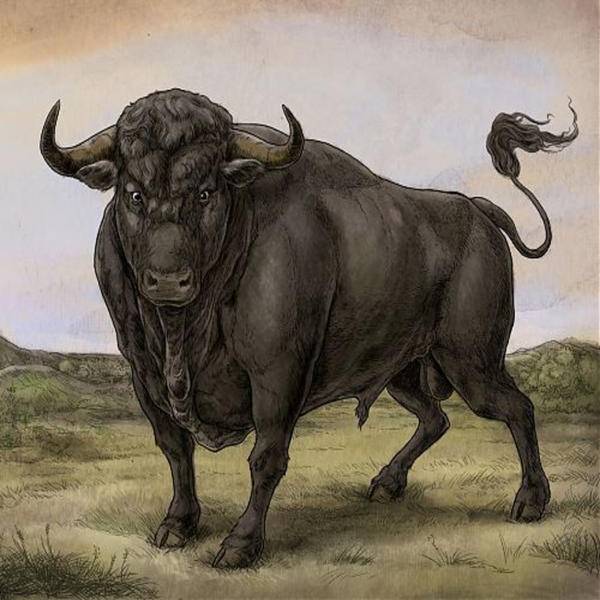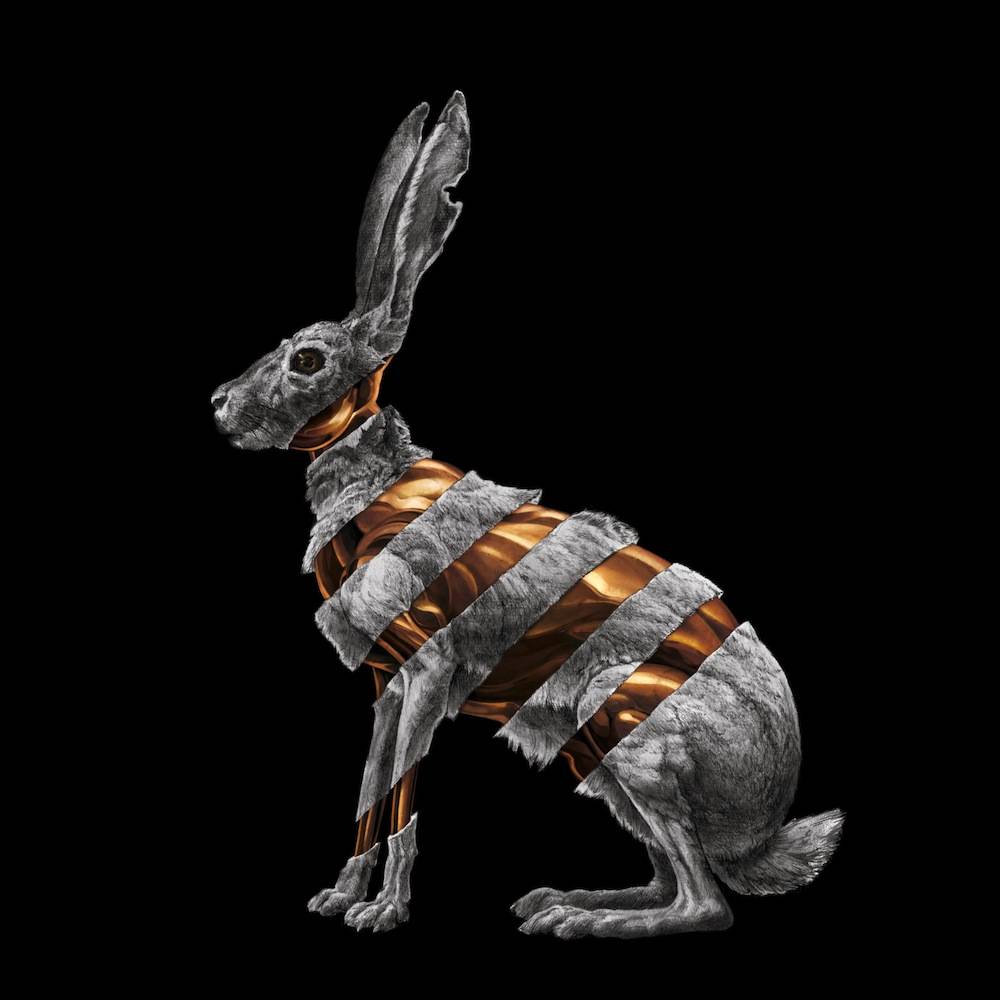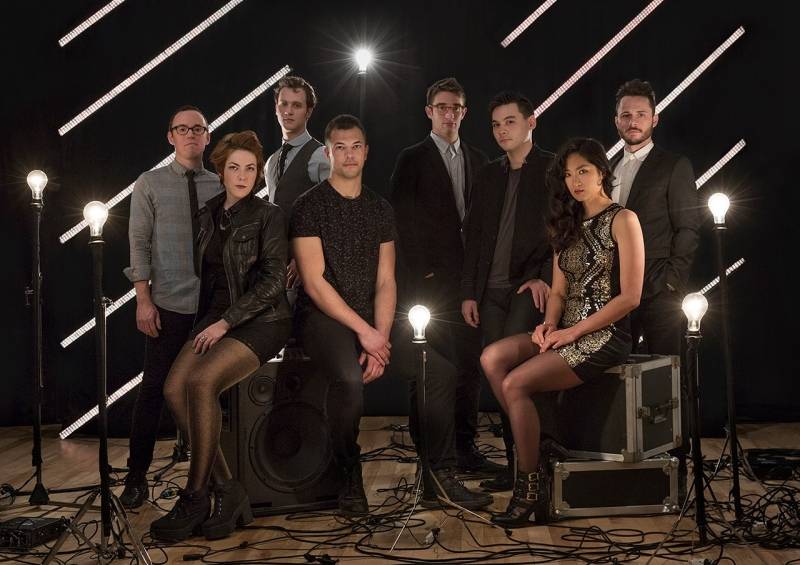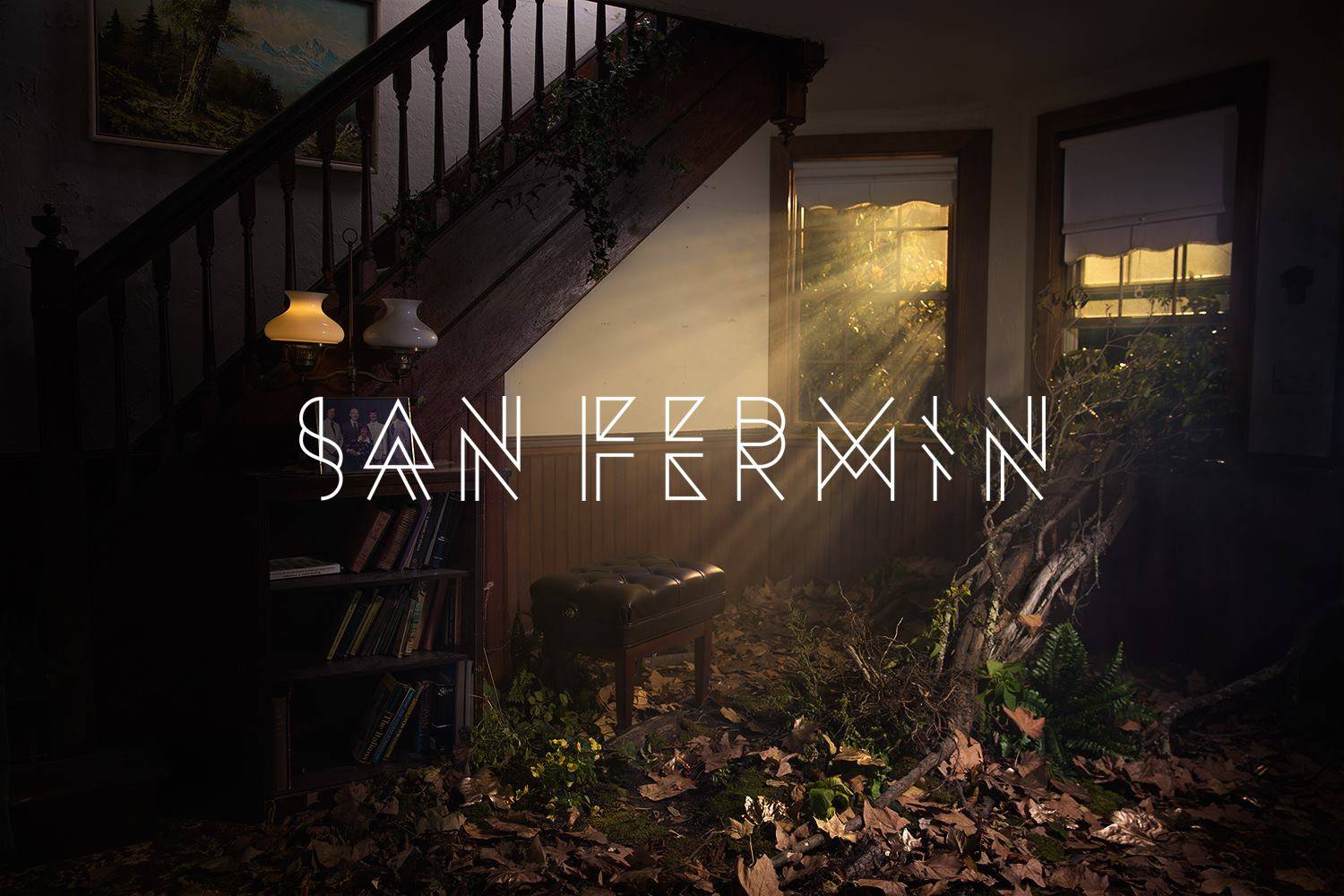It starts slowly, shuddering piano chords landing like an erratic footsteps. Then a hard-to-place noise comes in, clarinet or human, almost like an owl. It’s a warning, perhaps, or an invitation to go deeper into “The Woods”, the first track of San Fermin’s Jackrabbit. Violins waterfall, and Allen Tate’s rich baritone describes a moment out of a dark fairy tale: “We went, the two of us into / the woods behind the little school”. These woods are filled with witches, “pulling legs off salamanders”, who deliver a symbolic death in terms both revolting and erotically charged.
What a way to kick off a sophomore album. San Fermin began as the brainchild of Ellis Ludwig-Leone, a classically trained composer who works in the medium of elaborate, layered pop music. It features two powerful vocalists, who take turns delivering Ludwig-Leone’s darkly elegant lyrics. The previously mentioned Tate handles the more restrained tracks, often just hinting at deep emotions. Then the explosive Charlene Kaye delivers all the feelings, in a pent-up rush.
It’s easy to come up with parallels to bits and pieces of San Fermin’s sound. You can say that Tate’s vocals are like those of Matt Berninger from the National, or liken their use of orchestral flourishes and discordance to Dirty Projectors or Sufjan Stevens. But, really, there aren’t any bands that sound like San Fermin. There are hardly any bands trying to do what San Fermin is attempting. Some of that comes from the added step between composer and performer, which makes San Fermin relatively unique in an indie rock scene that’s singer/songwriter dominated. Mostly, though, it’s in the band’s ambition. San Fermin’s albums are lush, full of sweeping moments and operatic style. There are character arcs and recurring themes, lyrically and musically. Each album is a voyage, something best experienced as a whole.
Their first, eponymous album, sets a strong template. Each track charts another step in the psychic progress of its protagonist, an avatar for Ludwig-Leone. Every alternation of the male and female adds another layer, from the accusatory self-doubt of “Crueler Kind” to the longing of “Sonsick”. The album’s climax, “Daedalus”, evokes the image of the mythical father of Icarus, who lets go of his child even while knowing he may burn up in the sun or spiral into the ocean. The lyrics cycle through images of birth and death, over a framework of cello, bassoon, glockenspiel, and a Greek chorus of backing vocals. It’s a massive, ambitious track. In other hands or contexts it might come off as pretentious or precious. Here, though, with the thrust of the entire album placed behind it, every motion, musical and lyrical, seems to lead to this one epiphanic point.
Following up that moment was no easy task. Jackrabbit succeeds by using similar tools to tell another story entirely. If San Fermin was an album of self-discovery, Jackrabbit is an album all about losing yourself in the dark grove that “The Woods” invites you to. Charlene Kaye’s vocals on the title track are filled with jittery, lupine energy, commanding “Run for the hills, don’t look back”. All of the album’s characters are out of control, or spiraling in a haze of drugs and sex. The disconcerting cover art shows a rabbit that’s being either deconstructed or flayed. It perfectly captures how the album hits a sweet spot, both intelligent and visceral.
In preparation for the band’s show at the Accord this Friday, I talked with Ellis Ludwig-Leone about story arcs, composition, and how touring works when your band could field an Ultimate team (with extras for substitions).
Smile Politely: You sometimes get called a “crossover” band of some stripe. Do you feel San Fermin is a rock band, or would you call it something else?
Ellis Ludwig-Leone: Yeah, to me, I mean, it’s a band, you know, I try to write music that’s honest to what I listen to and to what I know how to do, which is often a mixture of things. But, yeah, we’re a rock band, we mostly play rock clubs. Basically, it’s the easiest way to talk about it.
SP: You’ve mentioned in other interviews that the songs from San Fermin had to be rearranged for a touring band, with fewer people. Did that change how you composed Jackrabbit?
Ludwig-Leone: It definitely did. I knew who the band was, and each of these instruments is actually a person to me, which really changes how you write. I think Jackrabbit was a little bit of a transition, because I was still in the mindset of the first record. It was kind of a transitional thing, where some songs felt more personalized to the band than others. But yeah, it definitely was the beginning of me realizing that this is a band, and it’s eight people who are in this thing. And that my role is to write music that works, not just as music, but as also as music for this specific group of people.
SP: So were the songs on Jackrabbit written while on tour in support of the first album?
Ludwig Leone: It is a mixture, I wrote some of them, actually, before we started touring. I wrote some of them while we were on tour, and I revisited and wrote some when we came back. So there’s really a pretty wide mixture. It sort of accumulated over the course of a year, and then we ended up recording it and mixing it just a year and a half after San Fermin came out.
SP: You’ve mentioned in a few previous interviews that the first album was structured as a conversation between two voices, both of which represented aspects of yourself. Do you feel like Jackrabbit continues in, or follows up on that?
Ludwig-Leone: Yeah, I think it kind of follows up on it, but also maybe tries to open that up a little bit. I think I felt that the idea of the male and the female character having a conversation, or an argument, was a cool idea, but also a little bit of a limiting one for the future of the band.
If every record we put out was like a developing conversation between two fictional characters it would be a little bit of a crutch maybe, a little hokey. With Jackrabbit I tried to open up who the voices really are. Sometimes they’re talking to each other but sometimes they’re kinda just talking to themselves. And I think both of them become more three-dimensional people, because that just made sense for the future of the band. Particularly, I think there’s only so many times you can write the kind of dramatic, operatic arc of the first record. I think after a certain point you want to get into something more specific, and perhaps more subtle emotional territory.
SP: Listening to Jackrabbit, I did feel like there was still a strong arc to it. How do you structure the story arc of an album like that?
Ludwig-Leone: I really love the album as a format. I love spending forty five minutes or an hour and going through a journey. That feels very important, so I definitely think about that a lot when I write. But it wasn’t quite as explicit, I think. On the first record there are some times where things really line up. Like, this song is a direct response to this song, this song fits into this kind of arc this way. On Jackrabbit it’s more like, taken together I think it all fits, but… I think there’s starting to be a development, on that second record, of songs just existing as the song itself. And maybe not as a link in some larger narrative.
SP: How does that all come into play when you’re selecting your setlists? Can you take songs from both albums, independently?
Ludwig-Leone: Yeah, we’re working towards that. I think ideally I’d like that. I think the best albums can really be read both ways. The songs themselves, you listen to it backwards and it still would be good, or you could listen in order and follow the whole thing as it sort of grows. And I think that’s the way the band is heading too.
Now we’ll sort of do something where I try to preserve little chunks of the albums. Maybe we’ll do the first three or four songs from Jackrabbit, and then we’ll do a couple from San Fermin in a row. But it’s a little bit more piecemeal. I do try to switch between the girl and the guy songs, Alan and Char, just because it seems like it’s a nice kind of flow. And also that’s a thing that’s pretty specific to us, that we have these two opposite sounding voices.
SP: It feels like the female songs, the ones Charlene sings, are a little more aggressive.
Ludwig-Leone: Yeah, it’s weird. When I write for Char, honestly, it’s much easier for me. I think I find she’s a really good outlet for… like the more anxious side of my songwriting. The more… maybe like knee-jerk kind of emotions. And I think I’m pretty good at harnessing those, because I’m a very anxious person. I definitely am in touch with that kind of fight-or-flight feeling.
Whereas when I’m writing for Alan I think of him as a little more measured, just because everything about him as a performer as a singer as a person is measured. I think a successful song for Alan sometimes is one in which he can really dig his teeth into the emotional subtleties of being an adult and having complicated feelings about something. The songs I write for him are often a little less manic, I guess.

SP: San Fermin has a bull on the cover, and then Jackrabbit has the rabbit. Did those animals feel totemic at all, to their respective albums?
Ludwig-Leone: I like the continuity, from the bull to the rabbit, that there’s an animal on the cover. But I don’t think of that necessarily as something that’s going to continue. For me, even the image itself is an interesting representation of how I was departing from the first record. The first record has this more lush landscape, that’s pretty realistic. And then the second one it’s starting to get kinda ripped apart… the image is still there but it’s being peeled away. So I think I needed that as a transition out of the way I was thinking about the first record. But yeah, I don’t know. It’s fun to have two records and two animals, but it’s not going to be like an animal per record kind of thing.

SP: The video for the song “Jackrabbit” feels like it does really literalize the rabbit metaphor. Were you involved in making that?
Ludwig-Leone: Yeah. I was a little less involved with the music videos for the second record, because I realize that music videos are fairly stressful and expensive endeavors. I found that on the first record I was a little bit consumed by them sometimes, and not always to the best result. I thought that the videos were great on the first record, but the experience of sort of controlling them all… On the second record I thought, well, maybe I’ll give up a little bit of control here. I still wrote the treatment, but it was pretty loosely interpreted, and it ended up just being a giant chase scene. Which was really fun, actually, and kind of what the song’s about, I guess. Basically, running away from something, though not being entirely sure of what you’re running from.
SP: Where are you guys driving from and to right now?
Ludwig-Leone: We are just leaving Memphis, we’re headed down to Dallas, we’re playing a show there tomorrow.
SP: Where did you play last night?
Ludwig-Leone: We were in Indianapolis, we played with the Indy symphony, which was actually really cool. The symphony hosts a festival there called the Infusion Music Fest. They played one of my pieces for orchestra. Ben Folds played one of his concerto for piano and orchestra, and Kishi Bashi played with a string quartet.
SP: So you got to hang out with Ben Folds?
Ludwig-Leone: Yeah, a little bit. Got to say hey. He’s a big hero of mine from growing up, so that’s pretty exciting.
SP: When you’re touring with eight people in your group, how do you do that logistically? Are you all in one giant van?
Ludwig-Leone: It depends on the tour. Often we’ll use Sprinters, because they’re pretty comfortable. Touring is always like a giant field trip, like your high school English class or something. But I like that aspect of it, because it keeps things from getting stale. And, you know, there’s always someone to talk to.

San Fermin will play at the Accord at 7:30 p.m., Friday, May 6th as part of the Pygmalion Show Series, along with Elsinore, the Besnard Lakes, and J. Fernandez. Tickets are $12 in advance and $15 at the door.
About Nathaniel:
Nathaniel Forsythe is a writer who lives in Champaign. In case you couldn’t tell, “Daedalus” is on his short list of tracks that absolutely wreck him every time he hears them.








